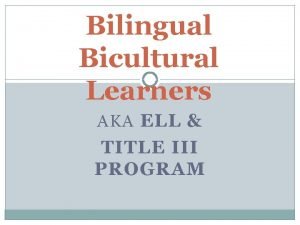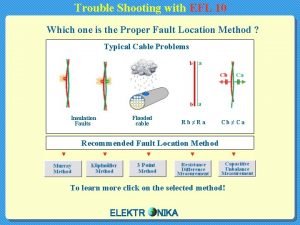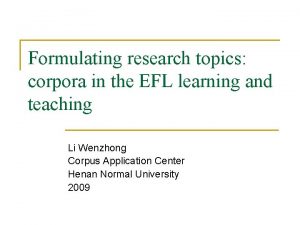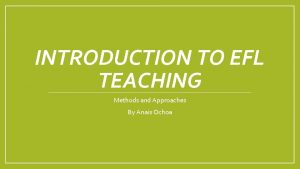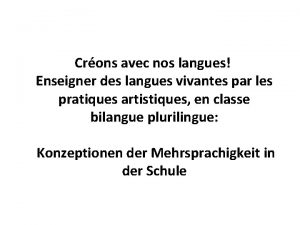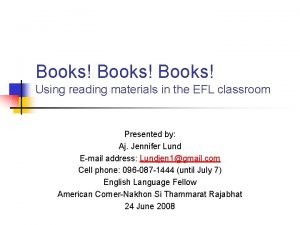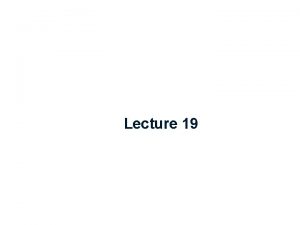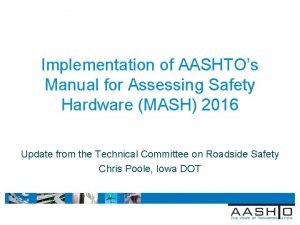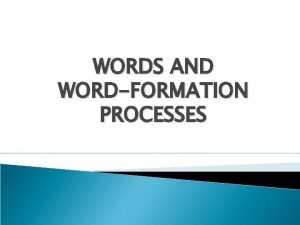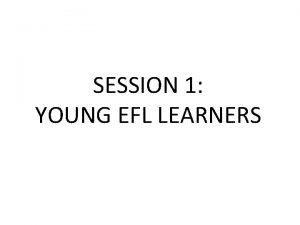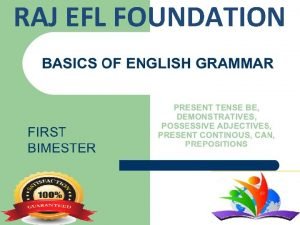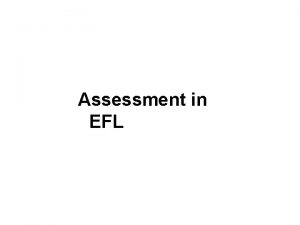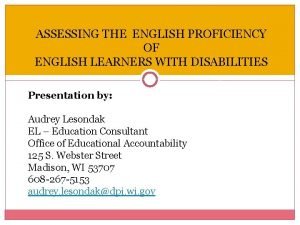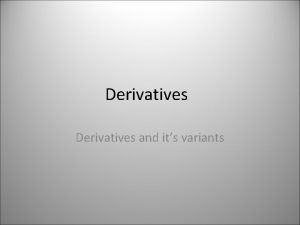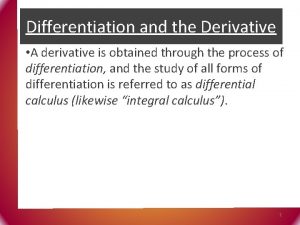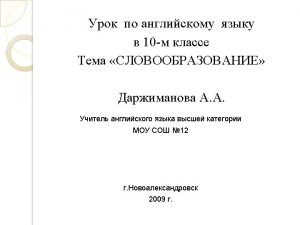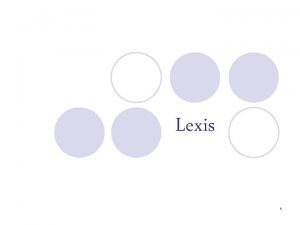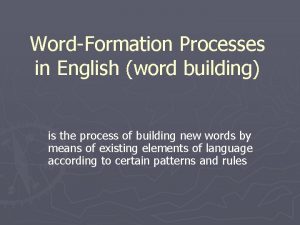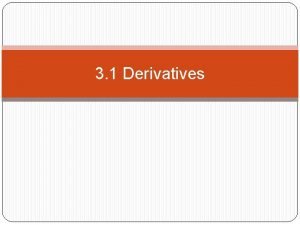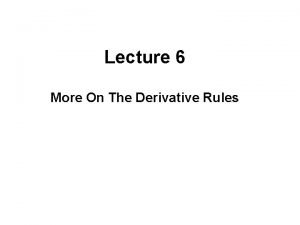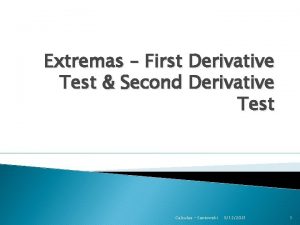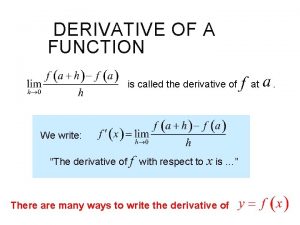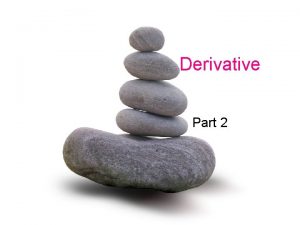Assessing derivative skills EFL learners and English wordformation





























- Slides: 29

Assessing derivative skills: EFL learners and English wordformation Katja Mäntylä and Ari Huhta katja. mantyla@jyu. fi, ari. huhta@jyu. fi

CEFLING Linguistic Basis of the Common European Framework for L 2 English and L 2 Finnish Ø Project funded by the Academy of Finland 2007 -2009 Ø Based at the University of Jyväskylä; part of the European SLATE network (Second Language Acquisition and Testing in Europe) Ø Homepage: http: //www. jyu. fi/cefling

Questions Ø How to test word formation skills? How do the three methods used in the study function – what are their pros and cons? Ø What is the relationship between the word-formation skills and overall written proficiency of Finnish school pupils ? Ø (What kind of knowledge do they have on English word-formation? ) Ø (How do their word-formation skills develop? ) Ø (Is there any difference between Finnish and Swedish speaking participants? )

Word-formation and SLA Ø Word-formation and SLA in general Mochizuki & Aizawa (2000) Nyyssönen (2008) Schmitt & Meara (1997) Schmitt & Zimmermann (2002) Ø Role in teaching English in a Finnish school? Ø Derivation chosen because • Productivity of the method • The participants familiar with it at least implicitly • (though textbook analysis shows that explicit teaching nonexistent)

Participants Ø 7 th - 9 th graders • 13 -16 –year-olds, have studied English as a FL for at least 4 -6 years • were administered three short word-formation tests (for practical reasons) • over 300 completed the word formation tests, about 150 of whom also completed four writing tasks as part of the main CEFLING project Ø Different parts of Finland

Word-formation test 1 (Productive gap-fill test) Ø Three written word-formation tests (revised after piloting) 1. Sentences / sentence pairs in English with a Finnish translation of the target word (from Waystage): I am ____ (varma) that he will get the job in London. He will _____ (varmasti) get the job in London. sure - surely

Word-formation test 2 (final version) (Non-words based test) 2. Sentences with non-words with explanations in Finnish (gap-filling): • Some of the non-words taken from the DIALANG placement test (English) designed by Paul Meara • Example in Finnish (with Finnish real words) She could bourble animals very well because she was a good ____ bourble____. (henkilö, joka tekee lihavoidun sanan kuvaamaa toimintaa/työtä) (a person who does the action described by the bolded word)

Word-formation test 3 (List-based test) 3. A list of prefixes from which the participants were to choose suitable ones to fill in the gaps in sentences anti- il- mini- non- pro- de- ir- mis- poly- re- dis- inter- mono- post- trans- intra- neo- pre- un- im- mega- He did not follow the instructions. He had ___ understood them.

Writing tasks Ø Email to a friend Ø Email to one’s teacher Ø Email to a store Ø Opinion piece Ø Narrative piece • Each student wrote 4 texts • Each text was assessed by 4 raters • the rating scale was a combination of several writing scales from the CEFR that best suited the writing tasks

Marking word-formation tests Ø Double marking Ø Scoring: Productive gap-fill test : 0 -1 -2 -3 -4 Non-words based test and List-choice based test: 0 -1 -2 Ø The respondents were very creative: minigabl Ø Spelling errors more or less ignored in scoring: unbelievubl, unbelievevabl, unbelievobl; understant, anderstand Ø (cf. shore sure, deffreno different)

Results of item analyses / characteristics of the tests One item turned out to be poor (despite piloting): 16. The dog started to ______ (seurata) the trail of a fox. 17. The hunter caught the fox the ________ (seuraava) day. seurata = to follow next / seuraava = following

Characteristics of the 3 tests Items Productive gap-fill test Mean Standard Median score deviat(percent) ion Cronbach’s Alpha for Average 40 -item / total test correlation 18 75. 1 19. 1 77. 6 . 86 . 93 . 56 8 34. 3 26. 4 25. 0 . 76 . 94 . 62 12 39. 3 22. 3 37. 5 . 78 . 92 . 54 38 55. 7 21. 3 49. 6 . 90 . 91 . 48 (n=326) Non-words based test (n=299) List-choice based test (n=327) All 3 tests together (n=327)

Characteristics of the 3 tests Items Productive gap-fill test Mean Standard Median score Deviat(percent) ion Cronbach’s 18 75. 1% 19. 1 77. 6 . 86 . 93 . 56 8 34. 3% 26. 4 25. 0 . 76 . 94 . 62 12 39. 3% 22. 3 37. 5 . 78 . 92 . 54 38 55. 7% 21. 3 49. 6 . 90 . 91 . 48 Alpha for Average 40 -item / total test correlation (n=326) Non-words based test (n=299) List-choice based test (n=327) All 3 tests together (n=327)

Characteristics of the 3 tests (analyses with the Tia. Plus programme) Items Productive gap-fill test Mean score (percent) Standard Median Deviation Cronbach’s Alpha for 40 -item test Average item / total correlation 18 75. 1% 19. 1 77. 6 . 86 . 93 . 56 8 34. 3% 26. 4 25. 0 . 76 . 94 . 62 12 39. 3% 22. 3 37. 5 . 78 . 92 . 54 38 55. 7% 21. 3 49. 6 . 90 . 91 . 48 Alpha (n=326) Non-words based test (n=299) List-choice based test (n=327) All 3 tests together (n=327)

Word-formation test 2 (Non-words based test) Sentences with non-words with explanations in Finnish: ITEM 1: She could bourble animals very well because she was a good ____ bourble____. (henkilö, joka tekee lihavoidun sanan kuvaamaa toimintaa/työtä) (translation of the Finnish text: ”a person who does the action / work described by the bolded word”)

Non-words based test ITEM 1 2 3 4 5 6 7 8 MEAN SCORE (PERCENT) ST. DEVIATION 74 33 48 31 9 16 41 22 (n = 299) ITEM / REST (on 0 -2 scale) ITEM / TOTAL CORRELATION (Hennyson’s correction) . 87 . 35 . 29 . 94 . 67 . 60 1. 00 . 70 . 64 . 93 . 53 . 46 . 56 . 44 . 36 . 73 . 64 . 54 . 98 . 59 . 52 . 82 . 31 . 25 CORRELATION

Non-words based test ITEM (n = 299) MEAN SCORE (PERCENT) ST. DEVIATION (on 0 -2 scale) ITEM / TOTAL CORRELATION 1 74 . 87 . 35 . 29 2 33 . 94 . 67 . 60 3 48 1. 00 . 70 . 64 4 31 . 93 . 53 . 46 5 9 . 56 . 44 . 36 6 16 . 73 . 64 . 54 7 41 . 98 . 59 . 52 8 22 . 82 . 31 . 25 (Hennyson’s correction) ITEM / REST CORRELATION

Correlations between word-formation tests N = 281 -310 A (total) A 1. items Productive tapping the gap-fill test base form A. Productive gap-fill test 1. 00 A 1. Items tapping the base form A 2. Items tapping the inflected form B. Non-words based test C. List-based test A 2. items tapping the inflected form B. Nonwords based test C. Listbased test (. 905) (. 971) . 567 . 618 1. 00 . 778 . 511 . 566 1. 00 . 544 . 596 1. 00 . 601 1. 00

Conclusions about test characteristics Ø Productive gap-fill test was rather easy for these test takers because the words were based on Waystage (A 2) for English Ø Non-words based and list choice based tests were quite difficult (but for different reasons) Ø Reliable (relative to their length) Ø Fairly high correlations between the different word formation tests but far from perfect not equivalent Ø The non-words based test appeared to be at least as good as the other, more traditional word-formation tests

Relationship between word-formation skill and more general language profiency n = 141 -160 WRITING SKILL (on CEFR scale) Mean rating across 4 raters and 4 tasks Productive gap-fill test . 696 Non-words based test . 652 List-based test . 742 All 3 tests together (raw score) . 798 All 3 tests (only derivated forms; IRT theta value) . 789 P =. 000

More specific questions about the relationship How did learners at different CEFR levels (in writing) perform in the word-formation tests? Do beginners (A 1 -A 2 levels) master English wordformation or does the ability to derive words develop only later?

Proficiency level Mean test result (% correct) Productive (median across 4 gap-fill test writing tasks) Non-words List-based All 3 tests based test together A 1 49 15 14 26 76 29 35 47 90 58 58 68 95 71 74 80 n = 21 -27 A 2 n = 53 -57 B 1 n = 45 -47 B 2 n=7

Proficiency level (median rating across 4 writing tasks) A 1 Mean test result (% correct) Productive gap-fill test Non-words based test List-based All 3 tests test together 49 15 14 26 76 29 35 47 90 58 58 68 95 71 74 80 n = 21 -27 A 2 n = 53 -57 B 1 n = 45 -47 B 2 n=7

Conclusions – word formation and the more general language proficiency Ø word formation skill(s) appear(s) to be related to more general language proficiency (writing skills) – correlation. 6 -. 8 Ø A 2 (and even A 1) level learners (in Finland) may know a reasonable number of conjugated English words when the words are fairly basic (Waystage / A 2 level) Ø however, the results suggest that learners have to be at B 1 / B 2 before they can apply English word formation rules more systematically

Comparison of the three word-formation test methods Pros Cons / issues Productive gap-fill test familiar test type memorising words? Non-words based test focus only on word-formation List-based test quick and easy to memorising words? take and mark somewhat unfamiliar test-type? suitability depends on the difficulty of the words relative difficulty and unfamiliarity of the test type suitability depends on the difficulty of the words

Frequency of the word & item difficulty Ø Is the frequency of the words related to their difficulty as test items? – the first test, the productive gap-fill test, based on Waystage words Ø Frequencies based on the British National Corpus Ø Rank order correlation between item difficulty and the word’s rank in the BNC was -. 429 (p =. 097, n = 16)

Future Ø Develop and trial longer versions of the word-formation tests, especially of the non-word based test Ø Qualitative study on the process of taking word formation tests (interview, think-aloud) – e. g. which way derivation occurs (always from the base form to the derivated form)? – effect of the unfamiarity of the non-words test Ø Analysis of the learners’ written performances for derivated forms and for other word-formation methods

Kiitos! Tack! Thank you!

Last item (item 8) in the non-words test I did not monadate the story that your friend told me yesterday but what you tell me now is much more _____monadate______. (= sisältää asiaa, jota lihavoitu sana kuvaa)
 Audioize
Audioize English language learners
English language learners Teaching young learners english
Teaching young learners english Reading strategies for english language learners
Reading strategies for english language learners Equal protection for english language learners
Equal protection for english language learners What should every efl teacher know
What should every efl teacher know Efl 10
Efl 10 Efl research topics
Efl research topics Efl
Efl Uifw
Uifw Efl epreuve facultative uf
Efl epreuve facultative uf Efl reading materials
Efl reading materials Włodzimierz sobkowiak
Włodzimierz sobkowiak Dr ray efl
Dr ray efl Ways to address grammar in the writing classroom
Ways to address grammar in the writing classroom Planning assessing and reporting domain 5
Planning assessing and reporting domain 5 Formal assessment in reading
Formal assessment in reading Assessing a new venture's financial strength and viability
Assessing a new venture's financial strength and viability Assessing leadership and measuring its effects
Assessing leadership and measuring its effects Many new drivers first fender bender is a backing collision
Many new drivers first fender bender is a backing collision Module 4 topic 1 assessing and managing risk
Module 4 topic 1 assessing and managing risk Code of ethics for teachers article 3
Code of ethics for teachers article 3 Deped gifted and talented program
Deped gifted and talented program Passive learning vs active learning
Passive learning vs active learning Intrapersonal skill adalah
Intrapersonal skill adalah Hard skills and soft skills
Hard skills and soft skills Btec sport unit 3
Btec sport unit 3 Unit 18 assessing children's development support needs
Unit 18 assessing children's development support needs Task analysis in hrd
Task analysis in hrd Manual for assessing safety hardware
Manual for assessing safety hardware

